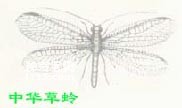Lacewing larvae prey on aphids, and they are known as aphid lions because of their fast and violent hunting movements and large prey quantities. The suckers formed by the upper and lower jaws of the larvae are long and pointed, extending in front of the head. The body is elongated, with pointed ends, and hairy tumors on both sides of the chest and abdomen. Mature larvae pupate in white round cocoons.

Adult insects are medium in size, have a slender body, are weak, green, yellow or off-white, most species are green, and have metallic or copper-colored compound eyes. The tentacles are long and filamentous. The shape and veins of the front and rear wings are very similar, transparent, with green or yellow veins. There are less than 30 transverse veins in the leading edge area of the wings, which are not bifurcated.
The eggs of lacewings are quite peculiar. They are laid on a long stalk. How are these long-stalked eggs produced? It turns out that when lacewings lay eggs, they first release a gelatinous substance from the ovipositor that comes into contact with the leaves. Then, while rowing, they lift the end of the abdomen and pull out an egg. Silk, the silk hardens when it encounters air, and finally lays an egg at the end of the silk, which sticks to the silk and lifts the egg high. This is because both adults and larvae of lacewings are predatory and feed on aphids. Lacewings usually lay their eggs on plants with many aphids in order to make it easier for their children to catch food after they are born. Plants with many aphids also have many ants, and the ants want to eat the honeydew of aphids' excrement. Therefore, in order to prevent the natural enemies of aphids and ants from eating the eggs, the lacewings lift the eggs high for protection.
There are more than 12,000 known species in the world, and the common ones in my country include giant lacewings, Chinese lacewings, etc. All species seen in farmland are species of the genus Chrysopa, which have been artificially raised in various places and used in biological control of aphids.
animal tags:
We created this article in conjunction with AI technology, then made sure it was fact-checked and edited by a Animals Top editor.